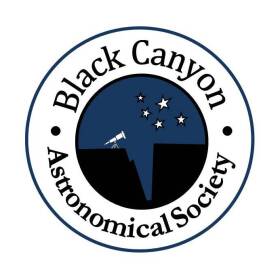
Western Slope Skies
Every other Friday at about 8:10 am, repeats the following Wednesday at 7:00 pm
Western Slope Skies is produced by members of the Black Canyon Astronomical Society, who take a look at our local night sky. Hear it every other week at 8:10 am, after the Friday morning regional newscast, and on the following Wednesday night at 7 PM, just before Global Express.
Do you have a question about the night sky or other astronomical topics? Ask it in our comments section below, or email us!
Latest Episodes
-
Back when our beloved western cities were still young and their skies still dark, customers waited weeks or even months for basic household items to reach their local mercantile shelves.
-
Imagine being a poor 13-year old boy living in France in 1744 and observing a 6-tailed comet in the daytime. What aspirations might that have generated in a teenager?
-
The name Milky Way means two things: the star-packed photogenic river of stars across sky for one. It also refers to the hundreds of billions of stars that make up our galaxy. No matter where you look in the Western Slope sky, every star is part of our galaxy.
-
Comets, once considered portents of doom, have long puzzled us. They move rapidly against the starry background. They grow tails, which may explain why the ancient Greeks called them “hairy stars.” Their brightness and even their exact paths can be hard to predict. So, what are these mysterious visitors that sometimes appear in our sky?
-
Maybe you’ve noticed the bright red “star” hovering high in the southern sky thiswinter. Maybe you’ve noticed it shining with a seemingly steadier light than otherstars in the night sky. Maybe you’ve even noticed it changing position relative tothe constellations. These observations reveal that this object is not a star, butrather the fourth planet from the Sun: Mars.
-
The vast universe that holds such mesmerizing beauty gives the mind something to contemplate as we look up at the night sky. Do you have a favorite star that you love to look at? Do you ever wonder how that special star came to be? Our amazing universe holds the elements that make up our very existence through the birth and death of stars.
-
Looking back through the episodes of Western Slopes Skies since 2015, I realized that I’ve written features for the end of the year numerous times. I enjoy taking stock of the year – and celebrating all that has happened. -Art Trevena
-
2023 is almost here, and astronomically a lot will be happening. The coming year features a “ring-of-fire” eclipse, meteor showers under dark skies, high solar activity, auroras, eye-catching planetary conjunctions, a possibly bright comet, and important milestones in space science.
-
Have you ever dreamed of flight? The constellation Pegasus has long been a symbol of courage and aerial daring for humans past and present. Late fall in a dark location offers perfect viewing of this winged horse.
-
Most of us take sight for granted. The farthest-ranging of our five senses, sight enables remote observation of events, and shapes our perception of time and causality.











